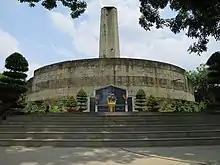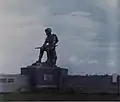Bình An Cemetery
The Bình An Cemetery (Vietnamese: Nghĩa trang Quân Đội Bình An) (formerly the Bien Hoa Military Cemetery (Vietnamese: Nghĩa trang Quân Đội Biên Hòa)) is a cemetery in Dĩ An, Bình Dương Province, Vietnam. It was an Army of the Republic of Vietnam (ARVN) military cemetery.[1][2][3]
 Central monument at the Cemetery | |
| Details | |
|---|---|
| Established | ~1965 |
| Location | |
| Country | Vietnam |
| Coordinates | 10.8893°N 106.8103°E |
| Type | Public |
| Owned by | Government of Vietnam |
| Size | 58ha |
| No. of graves | ~12,000 |
The cemetery was apparently established in 1965,[4] although the earliest graves appear to date from 1968.
The location of the cemetery was marked by a statue on Highway 1 by Vietnamese sculptor, Nguyen Thanh Thu, depicting a weary ARVN soldier seated with his M1 rifle on his lap that would come to be nicknamed Thuong Tiec. The statue stood at the beginning of a ceremonial road leading to a hilltop pagoda accessible by stairs, behind the pagoda was a ceremonial walkway leading into the cemetery with the graves laid out in a series of circles around a circular monument and obelisk.
The cemetery was built to hold a maximum of 30,000 graves and by the time of the Fall of Saigon in April 1975 approximately 16,000 burials had taken place there, with half the graves covered by cement and half simple dirt mounds. By 2009 total burials numbered approximately 12,000.[4]
Following the Fall of Saigon the Thuong Tiec statue was destroyed and access to the cemetery was restricted until 2006 when families were allowed to tend the graves.[4] A sign was erected outside the cemetery which read "Here lie the Americans' puppet soldiers who have paid the price for their crimes."[5]
In 2015 then United States ambassador to Vietnam Ted Osius visited the cemetery.[6]
 Thuong Tiec or weary soldier statue, November 1966
Thuong Tiec or weary soldier statue, November 1966 Cemetery entrance
Cemetery entrance graves in their original condition, April 2015
graves in their original condition, April 2015 original and renovated graves, April 2015
original and renovated graves, April 2015 graves being renovated, April 2015
graves being renovated, April 2015 graves being renovated and renovated graves, April 2015
graves being renovated and renovated graves, April 2015 graves renovated by families
graves renovated by families
References
- Vietnam, Now: A Reporter Returns - Page 99 David Lamb - 2003 "This cemetery, the South Vietnam equivalent of Arlington National Cemetery, was just off the highway in Bien Hoa and marked clearly with a sign. I don't remember the soldier's name, but I know he wasn't anyone prominent. He was just part of ..."
- Christina Schwenkel - The American War in Contemporary Vietnam: Transnational ... - Page 218 2009 "3. This contrasts with official military commemoration in the former Republic of Vietnam (see Figure 3.5). In the spatial configuration of the (now empty) graves at the RVN military cemetery I visited at Biên Hòa, men of rank were separated from ... As stated, this practice is generally not found in war cemeteries in contemporary Vietnam, with two important exceptions: Hanoi's Mai Dịch Cemetery, which contains the hierarchically arranged graves of government leaders and other famous revolutionaries, ..."
- "Fighting a Long Gone War". 2005.
- "Senator Webb promotes ARVN reconciliation and continued economic growth during December visit". Wikileaks. 9 January 2008. Retrieved 5 May 2015.
- Hastings, Max (2018). Vietnam: An Epic Tragedy, 1945-1975. Harper. p. 730. ISBN 9780062405661.
- "Letter from Ambassador to Edward R. Royce and Alan Lowenthal" (PDF). 27 October 2015. Retrieved 10 October 2019.
External links
| Wikimedia Commons has media related to Bình An Cemetery. |
